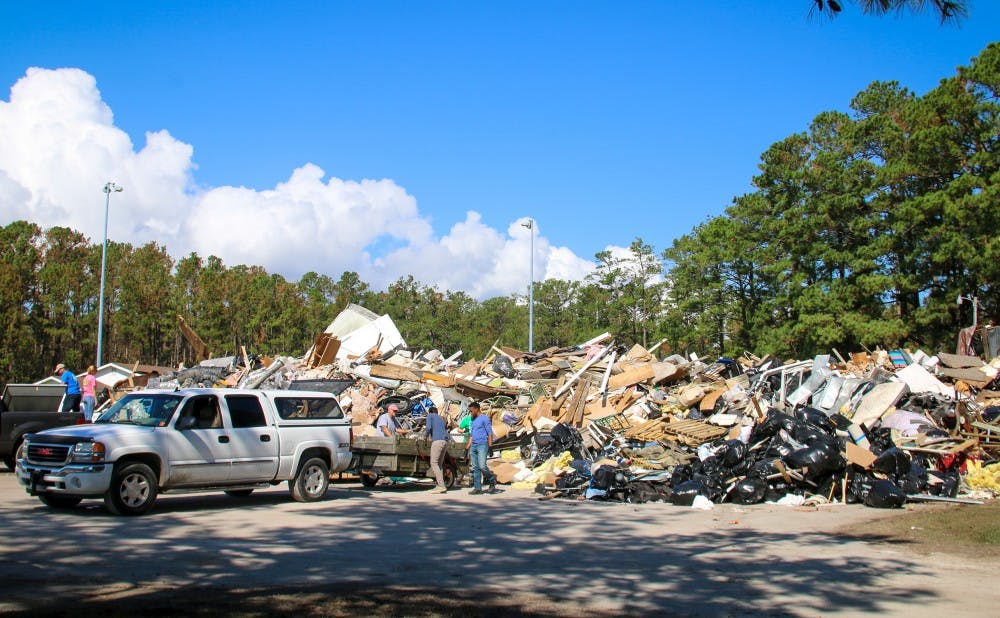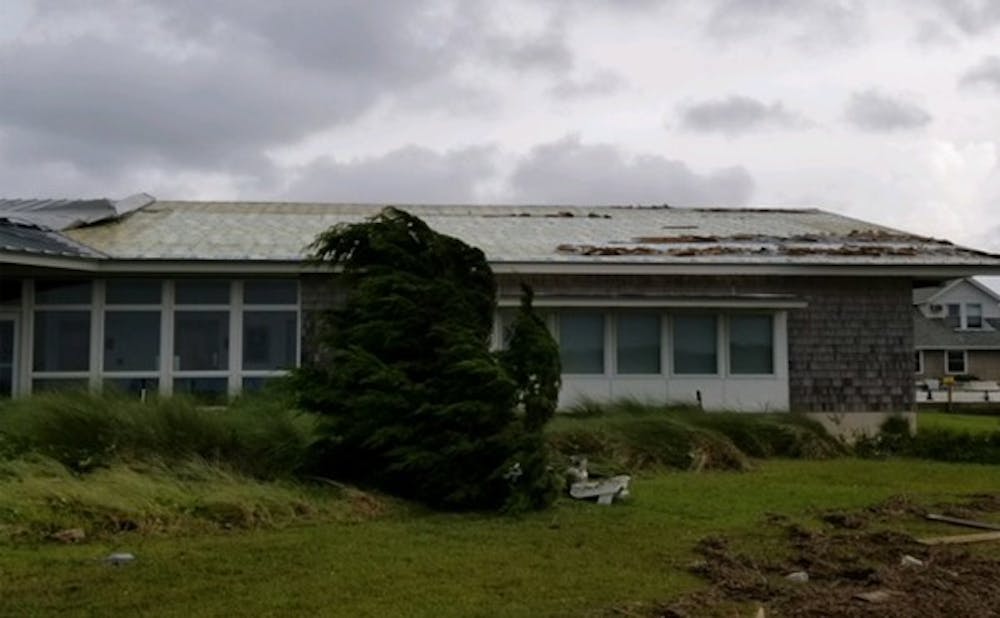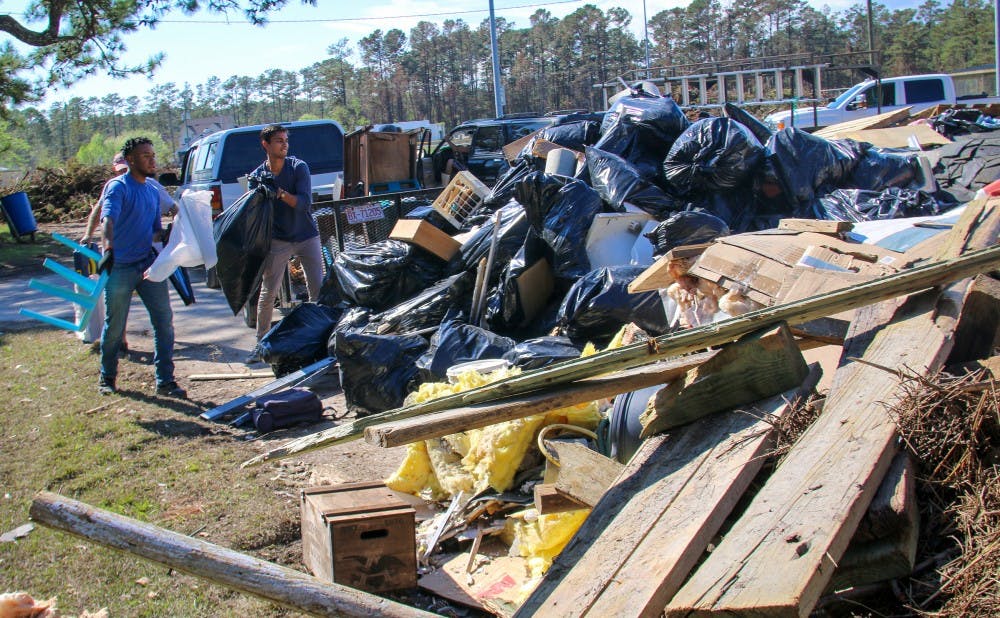Crawling inland at a slow rate of 3 miles per hour, Hurricane Florence dropped approximately 8 trillion gallons of rain on North Carolina.
In the short time since the hurricane, the Duke University Marine Laboratory has chipped in to play a small part in helping the slow recovery process.
The Hurricane made landfall south of Wrightsville Beach, N.C. on Sept. 14 as a Category 1 storm, yet Florence shattered previous flood records set by Hurricane Matthew in 2016. Gov. Roy Cooper announced in October that estimates of damage caused by the storm reached $13.7 billion, but the greater ecological impact has yet to be fully understood. Some coastal residents will still feel the effects of the damage for months to come.
Toxic flooding and pollution
Flooded rivers bring pollution and debris to the ocean, which can create dead zones where marine life cannot survive. In addition, the floodwaters can carry pollutants hazardous to human health across large distances.
“In North Carolina, when storms like Florence hit, there’s a delayed impact where the water will run down toward the coast through rivers and you’ll see flooding that doesn’t peak until a week after the storm,” WRAL investigative reporter Tyler Dukes said.
Eastern North Carolina’s economy has been supported by large-scale hog farms after the fall of Big Tobacco in the 1990s. Waste from the farms are flushed into open pit lagoons. Florence caused at least 110 of these lagoons to flood, killing 5,500 hogs and 4.1 million chickens and turkeys.
In addition to the flooding of hog lagoons, two Duke Energy coal ash pits experienced significant flooding. Coal ash is a byproduct of burning coal for energy production which contains toxic heavy metals such as mercury and arsenic.
Waterkeeper Alliance, an environmental advocacy group, released test results showing arsenic levels 71 times the state water quality standard by the Cape Fear Riverwatch downstream from the dam breach. Arsenic levels upstream of the dam breach were only a fraction of state standards.
The Department of Environmental Quality, however, released test results showing all but one heavy metal to be below state standards. Copper was detected at a level slightly above the standard. The Cape Fear Public Utility Authority said that any coal ash flooding would not threaten treated water being supplied to 200,000 people in Wilmington.

Stepping in to help
Although Florence made landfall south of Wilmington, Swansboro, a town further northeast along the coast, was hit with the most precipitation in the state, receiving over 33 inches of rain.
A 40-minute drive east from Swansboro lies Beaufort, the third-oldest town in the state and home to the Duke Marine Laboratory and other historic sites, including where Blackbeard the pirate ran his flagship the Queen Anne’s Revenge aground in 1718.
“Since Florence, we have pulled up over 100,020 pounds of debris including 11 vessels, 34 illegal moorings and seven car tires within Beaufort waterways. A lot of it was storm debris and some had been in place for quite some time,” said Rett Newton, PhD student at the Duke Marine Laboratory and Mayor of Beaufort.
Newton said the town was fortunate the hurricane made landfall as a Category 1 storm, as it had been classified as a Category 4 hurricane while still over the ocean. Duke Energy arrived in Beaufort with military grade equipment to try to turn the power back on.
The town ran out of food altogether, and rescue groups distributed Meals, Ready to Eat to citizens from the fire station. Across Carteret County, there was a need to provide shelter for displaced residents, but no place for them to go. Newton said the economic divide became very physically visible during the storm.
“Right after Hurricane Florence hit, it was clear that there was a lot of damage along the coast,” said Nancy Kelly, Director of Nicholas Community Engagement & Events at Duke. “Our response plan focused on Carteret County because of our Beaufort campus. The Marine Lab was severely damaged, but Duke has a lot of resources that others in the community do not.”
Get The Chronicle straight to your inbox
Sign up for our weekly newsletter. Cancel at any time.
Shortly after the storm, Marine Lab graduate students, postdocs and faculty mobilized to help recovery efforts. Students who had evacuated to Durham raised money on social media to fill their cars with relief supplies and bring them to the coast. As donations became more readily available in Beaufort, students packed up their cars once again to bring relief supplies to rural towns that faced more damage and received less help.
Duke undergraduate students also took initiative to help how they could. Trevyn Toone, a senior at the Marine Lab, made and sold t-shirts to people across Carteret and Durham counties raising over $1,000 for relief supplies purchases. Kelly also organized two day trips over fall break where undergraduate students in Durham could volunteer to help clean up in Carteret County.
About 30 or 40 students took the three-hour bus ride to Beaufort either day, bringing supplies from a donation drive on main campus and working to clean up houses that had been suffered water damage. They helped clean up mold, raked marsh grass, cleared yards and pitched tarps over roofs for first responders and members of the Boys & Girls Clubs of the Coastal Plains.
“Students went door to door checking in on citizens, offering rides to the FEMA office, helping with language barriers, identifying individuals who might need assistance,” said Rachel Lo Piccolo, PhD Program Coordinator at the Duke Marine Laboratory. “They took it on themselves to learn about FEMA and DSNAP, a federal program for emergencies allowing people to apply for money for groceries. The students learned about these programs and facilitated bringing them to the public.”

‘There is more work than there is labor’
Since much of the flood water didn’t reach the coast until a week after the storm, many buildings experienced water damage after Florence had left the area. The damage led to high incidences of black mold, which is highly linked to cancers and birth defects.
In Beaufort, the residents in units where mold was present were evicted and housed in emergency shelters. In more rural areas, many stayed in their damaged homes for shelter with nowhere else to go.
“Our house was not as badly damaged as others, but we had mold in the ceiling of our bedroom,” said Leslie Acton, a postdoctoral research fellow at Colorado State University living in the Beaufort area. “We tried to stay, but I have really bad allergies and was really sensitive. My eyes were red and swollen and people asked me if I got punched in the face. We stayed for three or four days and then stayed with friends around here.”
Acton and a group of her friends took loads of supplies in their car to underserved towns north of Beaufort, including Marymount and South River. Newton suggested they go to the smaller towns in the north because the towns to the east, which received more precipitation, were better organized and had clearer avenues to get resources.
“The key needs were information about FEMA, food aid and lost wages aid. I knew that kind of information but was not getting to a lot of people who needed it the most,” Acton said. “There were a lot of rumors going around that people were stopping at houses and pretending to be FEMA to come inside and stake out the houses to rob.”
Much of the community began communicating via a Facebook group called “Beaufort NC – Florence Community Support Group.” The group’s name has since been changed to “Beaufort / Down East Community News” and continues to serve as a place where residents can ask questions, find links to apply for FEMA and find housing such as FEMA trailers.
Marian Tucker and Brenda Lee of Newport also created a nonprofit called Carteret Warriors for Recovery about two weeks after Florence.
“I felt lucky that we didn’t have any major damage at our house, just a little roof damage,” Tucker said. “I wanted to help people that weren’t as fortunate and basically through the generosity of our community, we’ve been able to get the group off the ground.”
The nonprofit has helped supply over 300 families with clothing, linens, houseware appliances and furniture, especially mattresses. They’ve expanded to help Carteret, Onslow and Craven counties. About half of the 300 families lost everything in the storm initially, while the rest were later evicted from their apartments due to water damage. Tucker estimates that only about 25 percent of the families they’ve helped are back in their homes.
“Duke has millions of dollars to pour into restoration effort, but there aren’t enough contractors to do the actual work to rebuild,” said Stacy Zhang, PhD student at the Duke Marine Laboratory. “People are coming from all over the country right now to help rebuild, but there is more work than there is labor.... I drive by a lot of the homes we put tarps on, and the tarps are still there three and a half months later.
“We’ve seen trucks and vans from Alabama and Arkansas. Contractors are coming in from everywhere to try to help,” added Acton, who moved back into her home on Dec. 3.
The Marine Lab community also made counseling and mentoring local children a key part of the recovery process. They brought mental health professionals from Durham to volunteer and offer services to children at the Boys and Girls Club of the Coastal Plains and Carteret County Public Schools. In addition, students, staff and faculty volunteered at local Boys and Girls Clubs to help after the complete destruction of the facilities and to become long-term mentors to local families.
Elizabeth Demattia teaches a service learning course at the Duke Marine Lab where students created science and art projects to show both the physical and emotional effects of Florence. They made a “heat map” by asking children what they would tell the hurricane if they could or what they would tell other community kids.
“We want people to read the words. There were times when I teared up,” Demattia said. “Half of my class really wanted to talk about the justice and mental health of hurricane trauma and the other half wanted to talk about protections from the shoreline and ecological response.”
Navigating FEMA paperwork
Despite the efforts of the community to provide information about applying for FEMA reimbursements, the process remained confusing for many residents. FEMA requires applications and supplies funds meant to supplement already existing insurance. A homeowner needs to be able to show that the damage was caused by the hurricane, a complicated process that differs in the amount of proof needed for wind and water damage.
“I heard that if people got denied, it could have been because they were helping out the people who had the most intense damage first and that if you appealed your denial, you had an okay chance of being approved that time,” Acton said. “I don’t know if that’s accurate, but a lot of people at the Marine Lab had a lot of damage that only became clear after the fact, such as a small leak that caused mold and became catastrophic later on.”
Acton sought out FEMA workers directly to try to distribute information to the families of the Boys and Girls Club of the Coastal Plains and to the northern towns she had visited that weren’t receiving much help.
“A FEMA person went to North River one day but only had one or two people come and sign up. Reasons for that could be a ton: bad advertising, people already applied, people might not have been home, couldn’t get to the fire station, trust issues and all kinds of tensions,” Acton said. “It’s unfortunate they didn’t help as many people as they wanted to and I’m afraid that’s going to deter them from helping in the future.”
Most homeowners were still awaiting federal assistance from Matthew when Florence hit.
North Carolina received less than 1 percent of the federal refunds requested after Hurricane Matthew in 2016, which only estimated $1.5 billion in damage as opposed to Florence’s $13.7 billion. As of Sept. 1, North Carolina had only released $2 million of the $266 million it received in federal rebuilding money after Matthew.
What comes next?
Cooper’s $1.5 billion plan for Florence recovery anticipates help from private insurance and federal and state government. He initially released $56.5 million for immediate recovery. He is proposing to put $750 million in a special fund in the state budget for 2019 to pay for future storm relief.
He also emphasized that taxes would not be raised in order to do this. The relief money is meant to get displaced people in permanent homes, help small businesses survive and help the state’s agriculture industry.
As the funds to support hurricane relief programs are being redistributed elsewhere, the country continues to face climate change events that are potentially increasing the intensity of hurricanes. Hurricanes form over warm seas, and in the past 100 years, the global average sea temperature has risen by about 1 degree Celsius.
The Duke Marine Lab and other organizations are already investigating the environmental impact of Florence as well as ways to increase natural defenses along shorelines such as rock walls, oyster sills, marshes and jetties, which help protect more than man-made sea walls.
“I think we have so many natural disasters happening back to back it’s hard to remember that people are deeply affected for years,” Kelly said. “I really want to encourage people to come outside of their little bubble and help those that are in need. It’s so widespread it can be overwhelming, but if everyone pitches in a little bit, it really does go a long way.”

